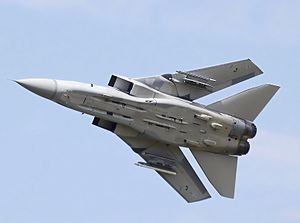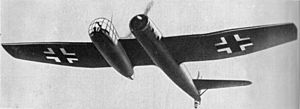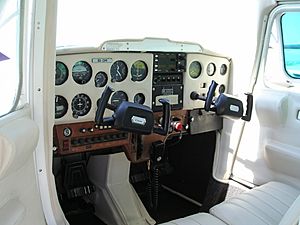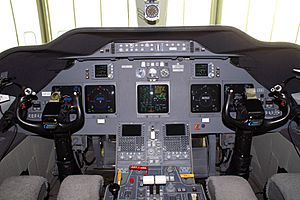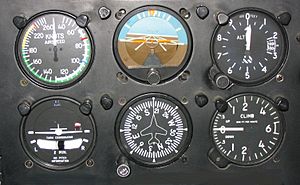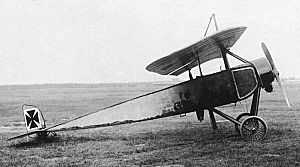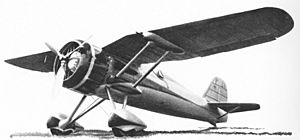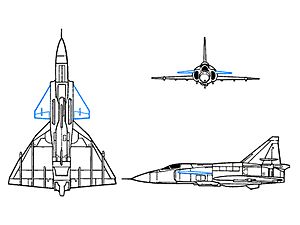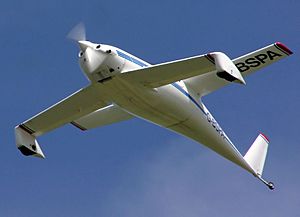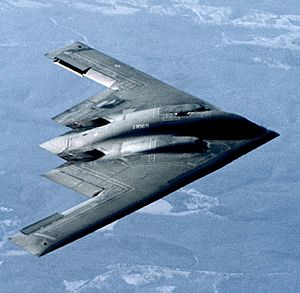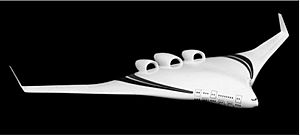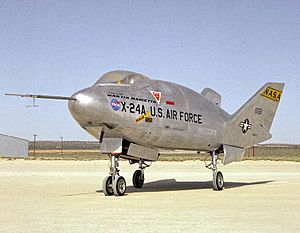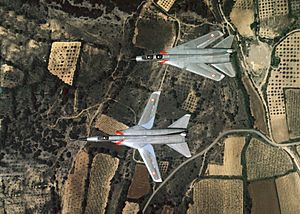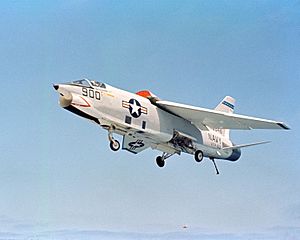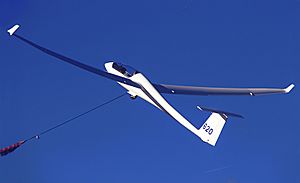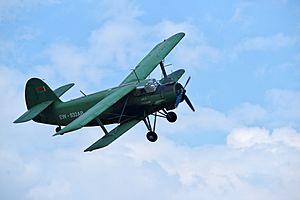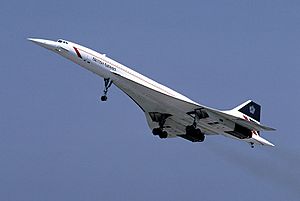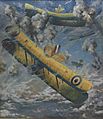Fixed-wing aircraft facts for kids
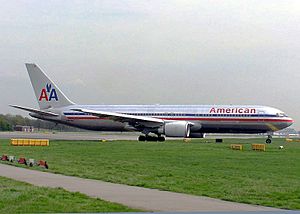
A fixed-wing aircraft is a type of aircraft. An aircraft is a machine that can fly, even though it's heavier than air. Fixed-wing aircraft are often called airplanes, aeroplanes, or simply "planes." All fixed-wing aircraft have wings that use forward speed to create lift. Gliders are fixed-wing aircraft that do not have engines.
Contents
- Exploring Aircraft History
- How Airplanes Are Built
- Different Kinds of Airplanes
- Aircraft Layouts: How Wings Are Arranged
- Monoplanes: Single-Wing Aircraft
- Biplanes: Two-Wing Aircraft
- Triplanes and Multiplanes: More Than Two Wings
- Canard Aircraft: Front Control Surfaces
- Tandem Wing Aircraft: Wings One After Another
- Flying Wing Aircraft: No Clear Body
- Blended Wing Body Aircraft: Smoothly Combined
- Lifting Body Aircraft: Body Creates Lift
- Wing Shapes: How Wings Look from Above
- How Airplanes Get Power: Propulsion Types
- Aircraft Layouts: How Wings Are Arranged
- Image gallery
- Images for kids
Exploring Aircraft History
Many old stories talk about flying, like the Greek legend of Icarus and Daedalus. Around 400 BC in Ancient Greece, Archytas is said to have built the first self-moving flying machine. It was shaped like a bird and powered by what was probably steam, flying about 200 meters.
Some of the earliest tries with gliders were by the poet Abbas ibn Firnas in the 800s and the monk Eilmer of Malmesbury in the 1000s. Both pilots got hurt in their experiments.
Leonardo da Vinci studied how birds' wings worked. He designed a human-powered aircraft in his book Codex on the Flight of Birds (1502).
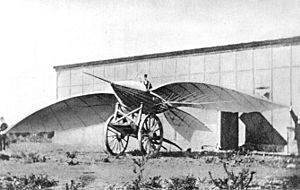
In 1799, George Cayley came up with the idea for the modern airplane. He imagined it as a fixed-wing machine with separate parts for lift, moving forward, and steering. Cayley built and flew model fixed-wing aircraft as early as 1803. He even built a successful glider that carried a passenger in 1853.
In 1856, a Frenchman named Jean-Marie Le Bris made the first powered flight. His glider, "L'Albatros artificiel," was pulled by a horse on a beach. In 1883, American John Joseph Montgomery made a controlled flight in a glider. Other early flyers like Otto Lilienthal, Percy Pilcher, and Octave Chanute also made similar flights.
The first jet airliner, the de Havilland Comet, started flying in 1952. The Boeing 707, a very successful commercial jet, flew for over 50 years, from 1958 to 2010. The Boeing 747 was the world's largest passenger plane from 1970 until the Airbus A380 took its place in 2005.
How Airplanes Are Built
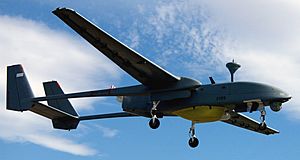
Most fixed-wing aircraft have these main parts:
- A fuselage: This is the long, thin body of the plane. It's usually shaped like a cylinder with pointed ends to help it move smoothly through the air. The fuselage holds the flight crew, passengers, cargo, fuel, and engines. Pilots fly the plane from the cockpit at the front or top of the fuselage. Some planes might have more than one fuselage or special booms.
- A large horizontal wing: This part has a special airfoil shape. As the plane moves forward, the wing pushes air downward, creating lift to keep the aircraft in the air. The wing also helps keep the plane stable from tilting left or right (called roll). Small parts on the wing called ailerons control this tilting. There are many different wing configurations, like multiplane or delta wing shapes.

- A vertical stabiliser: This is a vertical fin at the back of the plane, usually sticking up. It helps keep the plane stable from turning left or right (called yaw). It also holds the rudder, which controls this turning.
- A horizontal stabiliser or elevator: This is a horizontal part at the tail of the plane, near the vertical stabilizer. It helps keep the plane stable from tilting up or down (called pitch). It holds the elevators, which control pitch. Some planes use a front-mounted canard instead of a rear horizontal stabilizer.
- Engines: Powered aircraft have one or more engines that push the plane forward. The most common types are propellers (turned by piston or turbine engines) and jet engines. Jet engines create thrust directly from the engine, often with a large fan inside.
- Landing gear: This is a set of wheels, skids, or floats that support the plane on the ground. Seaplanes use the bottom of their body or floats to stay on water. On some planes, the landing gear folds up during flight to reduce drag.
There are many different airplane designs. Some planes have more than one fuselage or extra pods. Some have multiple horizontal or vertical stabilizers. V-tail aircraft combine the horizontal and vertical stabilizers into diagonal surfaces. While these parts are usually essential, some aircraft have flown by changing other parts to do the job of a missing component. A flying wing has no clear fuselage or tail, with most parts inside the main wing. A lifting body has no wings, but its body creates lift. Delta wing aircraft often don't have a horizontal stabilizer.
Most aircraft are mostly symmetrical, meaning they look the same on both sides.
How Pilots Control Airplanes
Pilots use several controls to steer aircraft in the air:
- A yoke or joystick: This controls how the aircraft tilts up/down (pitch) and left/right (roll). A yoke looks like a steering wheel, while a control stick is a joystick. Pushing the yoke or stick down makes the plane pitch down, and pulling it up makes the plane pitch up. Turning the yoke or tilting the stick rolls the aircraft. Pitch changes help adjust the plane's height and speed. Roll changes help the plane turn with the rudder.
- Rudder pedals: These control how the aircraft turns left or right (yaw). There are two pedals; pressing one forward makes the other go back. Pressing the right pedal makes the plane yaw right, and the left pedal makes it yaw left. The rudder is mainly used to help the plane turn smoothly or to correct for winds.
- A Throttle or thrust lever: Each engine has one of these. They control the power from the engines and, therefore, the plane's speed.
- Brakes: Used to slow down and stop the aircraft on the ground. They can also help with turns on the ground.
These controls became standard during World War I.
Other controls might include:
- Flap levers: Used to move the flaps on the wings.
- Spoiler levers: Used to move spoilers on the wings, which reduce lift for landing.
- Trim controls: These are usually knobs or wheels that adjust pitch, roll, or yaw trim. Trim helps reduce the effort needed to keep the plane flying straight.
- A tiller: A small wheel or lever used to steer the aircraft on the ground (mostly on larger planes).
- Undercarriage retraction levers: To raise or lower the landing gear, reducing drag during flight.
- A parking brake: Used to stop the aircraft from rolling when parked.
Some aircraft have automation like an autopilot or a flight management system. Pilots can set these controls to maintain a specific flight path or mode. Larger and more complex aircraft usually have more automation.
What Pilots See: Aircraft Instruments
Instruments give pilots and co-pilots important information. Flight instruments show the plane's speed, direction, height, and how it's tilted. Powerplant instruments show how the engines are doing. Systems instruments show information about other parts of the plane, like fuel and electricity. Navigation and communication instruments include all the radios.
An aircraft that uses computer screens (CRT or LCD) instead of traditional dials is said to have a glass cockpit.
The Six Basic instruments (often called the "six pack") are:
- An Airspeed Indicator: Shows how fast the plane is moving through the air.
- An Altimeter: Shows the plane's height above sea level.
- A Heading indicator: Shows the direction the plane's nose is pointing.
- An Attitude indicator: Shows the plane's exact tilt (pitch and roll).
- A Vertical Speed Indicator: Shows how fast the plane is climbing or descending.
- A Turn Coordinator: Helps the pilot keep the plane balanced while turning.
Different Kinds of Airplanes
This section looks at how many wings an aircraft has, which helps tell different types apart. A wing is a single part that goes from one end to the other. Any breaks for the fuselage or engine don't count. This single wing creates lift by making high pressure below it and low pressure above it. Where these meet at the wingtips, they cause drag. More wings mean more drag, so fewer wings are usually more efficient. However, sometimes more than one wing is needed.
Besides the number of wings, the shape of the wing when seen from above also helps identify the type.
Aircraft Layouts: How Wings Are Arranged
Monoplanes: Single-Wing Aircraft
A monoplane is a fixed-wing aircraft with just one main set of wings. Since the late 1930s, this has been the most common type of fixed-wing aircraft. Early monoplanes used wires outside the wing for support. But because people didn't fully understand the forces on wings, many failed. In the United Kingdom, the Royal Flying Corps even banned them.
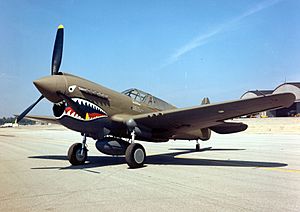
The wing shapes back then were very thin and couldn't hide strong internal supports. So, people tried adding external frames, which looked like a biplane but without the lower wing. This added a lot of drag. Junkers started trying out thicker wing shapes, which were thought to be inefficient before. With thicker wings, a strong support structure could be built entirely inside the wing. This also made the thicker wings more efficient.
Monoplanes can be grouped by where their wings connect to the fuselage:
- low-wing: The bottom of the wing is at or below the bottom of the fuselage.
- mid-wing: The wing is attached in the middle of the fuselage.
- shoulder wing: The wing is attached above the middle of the fuselage.
- high-wing: The top of the wing is at or above the top of the fuselage.
- parasol-wing: The wing is placed above the fuselage, usually supported by struts and wires. These were popular in the 1920s and 1930s.
- gull wing: Similar to a parasol wing, but the wing roots (where they connect) drop down to pass through the fuselage. This reduces the number of support struts needed. A variation is the inverted gull wing, which looks like a "W" from the front. This design helps shorten the landing gear and simplify the wing connection. The Vought F4U Corsair from World War II famously used this.
Biplanes: Two-Wing Aircraft
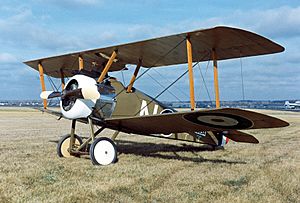
A biplane is a fixed-wing aircraft with two main wings stacked one above the other. The Wright brothers' Wright Flyer was a biplane, and most early aircraft used this design. The main reason was that two wings connected by struts formed a very strong structure. However, the struts and extra wing surface created more drag, making them slower. Some later biplanes used a different type of support that reduced drag, but it wasn't enough to compete with cantilever monoplanes, which became dominant by the late 1930s. Biplanes are still used today for aerobatics (stunt flying) and crop dusting because their compact size allows for great maneuverability. A sesquiplane is a type of biplane where one wing (usually the lower one) is much smaller than the other.
Triplanes and Multiplanes: More Than Two Wings
A triplane is a fixed-wing aircraft with three wings stacked vertically. Only a very small number of triplanes were ever built. They offered great maneuverability and a very good climb rate. However, like biplanes, they had a lot of drag. This type of aircraft is now outdated and rarely used, except for replicas of early triplanes like the Fokker Dr.I and Sopwith Triplane. A multiplane has more than three wings, but this design is even rarer because the problems of triplanes become even worse.
Canard Aircraft: Front Control Surfaces
A canard aircraft has a small control surface at the front, called the "canard," and the main wing at the back. This is different from a traditional aircraft, which has a small horizontal stabilizer behind the main wing.
Canard designs come in two main types:
- Lifting-canard: The weight of the aircraft is shared between the main wing and the canard wing.
- Control-canard: Most of the aircraft's weight is carried by the main wing. The canard wing is mainly used for steering the plane up or down during maneuvers. It usually operates at a zero angle of attack.
Tandem Wing Aircraft: Wings One After Another
A tandem wing aircraft has two sets of wings, one in front of the other, instead of stacked on top. NASA research has shown that these wings must have different lifting qualities, or the plane will shake badly. This has limited their use. A tandem wing can be told apart from a canard by where the pitch controls (elevators) are located – on the rear wing. A tandem wing might have the front wing larger than the rear, or vice versa. They usually use fewer struts than biplanes, but they still have the drag that comes from having multiple wings.
Flying Wing Aircraft: No Clear Body
A flying wing is a tailless fixed-wing aircraft that doesn't have a clear fuselage. Most of the crew, cargo, and equipment are held inside the main wing structure.
The flying wing design was studied a lot in the 1930s and 1940s. After World War II, many experimental designs used this idea, but the known problems were hard to solve. Interest continued until the early 1950s, but these designs didn't offer a big advantage in range and had many technical issues. So, "traditional" planes like the Convair B-36 Peacemaker and the Boeing B-52 Stratofortress became more common. Because a flying wing needs a deep wing, it's most practical for slow to medium-speed planes. There has been ongoing interest in using it for military transport aircraft.
Interest in flying wings came back in the 1980s because they could be hard for radar to detect. Stealth technology uses shapes that only reflect radar waves in certain directions, making the aircraft hard to find. This led to the Northrop Grumman B-2 Spirit stealth bomber. In this case, the main goal wasn't just aerodynamics. However, modern computer-controlled fly-by-wire systems helped reduce many of the flying wing's aerodynamic problems, making it an efficient and stable long-range bomber.
Blended Wing Body Aircraft: Smoothly Combined
Blended Wing Body (BWB) aircraft have a flattened, wing-shaped body that creates most of the lift. They also have distinct wing structures that smoothly blend into the body.
So, BWB aircraft combine features from a futuristic fuselage and a flying wing. The main benefits of the BWB approach are efficient high-lift wings and a wide, wing-shaped body. This means the entire aircraft helps create lift, which can lead to better fuel economy.
Lifting Body Aircraft: Body Creates Lift
A lifting body is a fixed-wing aircraft where the body itself produces lift. Unlike a flying wing, which is mostly wing, a lifting body is mostly fuselage with little or no traditional wing. While a flying wing tries to be super efficient at subsonic speeds by getting rid of non-lifting parts, lifting bodies generally aim to reduce wing drag and structure for subsonic, supersonic, and hypersonic flight, or for spacecraft re-entry. All these flight types make stable flight a challenge.
Lifting bodies were a big area of research in the 1960s and 70s. The US built several famous lifting body rocket planes to test the idea. Interest faded when the US Air Force became less interested in manned missions. Major development stopped during the Space Shuttle design process because the highly shaped fuselages made it hard to fit fuel tanks.
Wing Shapes: How Wings Look from Above
Straight Wing: Simple and Direct
A straight wing is a wing shape where the main lifting part of the wing forms a straight line from one wingtip to the other. This was the most common wing shape until early planes that flew near the speed of sound started using swept wings to reduce drag. Modern fighter jets can use straight wings again thanks to new designs and devices that help with lift.
Swept Wing: Angled for Speed
A swept wing is a wing shape where the wings are angled backward, so the tips are closer to the tail than the parts connected to the body. This design helps reduce drag when approaching supersonic speeds and is mainly used on airliners and other jet transport planes. A variation is the forward swept wing, where the wings are angled forward. This creates serious structural challenges, so it hasn't been used much. However, it was tried because regular swept wings have poor stall characteristics. When a plane stalls (loses enough lift to fly), ideally the nose should drop, allowing the plane to regain speed. In a swept-wing plane, a stall usually makes the nose go up, making recovery difficult.
Variable Geometry: Wings That Change Shape
Variable geometry aircraft are "fixed-wing" planes where the wing shape can change during flight.
A variable-sweep wing is an airplane wing that can sweep back and then return to its original position while flying. This offers many benefits, especially for takeoff distance, carrying heavy loads, and fast, low-level flights. However, this design adds a lot of weight and complexity. New flight control systems in the 1970s made many of the disadvantages of a fixed wing less important. No new variable-sweep wing aircraft have been built since the Tu-160 (1980).
Variable camber wings change the curve (camber) of the airfoil. Modern commercial airliners use various flaps and slats on their wings to do something similar.
A variable-incidence wing has an adjustable angle of incidence (the angle between the wing and the fuselage). This helps reduce landing and takeoff distances.
The extra parts add weight and increase maintenance costs. In some aircraft, the benefits were worth the costs, like the Vought F-8 Crusader. However, no modern aircraft has used this design since the F-8.
An oblique wing (also called a slew wing) is a variable geometry wing idea. On such an aircraft, the wing rotates on a central pivot. One tip sweeps forward while the other sweeps backward. By changing its sweep angle, drag can be reduced at high speed (when swept) without losing performance at low speed (when straight).
Delta Wing: The Triangle Shape
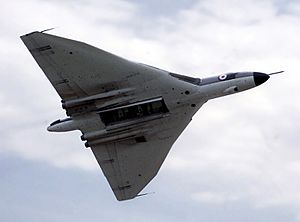
The delta wing is a wing shape that looks like a triangle. It's named after the Greek letter delta (Δ). This shape has many advantages. A delta wing has more internal space for fuel or weapons than a wing of similar thickness. It also allows for less wing loading for the amount of drag created in level flight. If its front edge is angled back enough, it can avoid the shock wave that forms at the plane's nose when it reaches transonic speeds, greatly reducing drag. Also, the center of lift moves less than on traditional planes, reducing trim drag. As the angle of attack increases, the front edge of the wing creates a vortex that smooths the airflow. This gives the delta wing a very high stall angle (meaning it can fly at a very steep angle without stalling), but at the cost of high induced drag. This allows for a wider range of speeds than a traditional wing designed for high-speed flight. Pure delta-wings became less popular because they were bumpy at low altitudes and new high-lift devices emerged. However, many of their benefits are still used with leading-edge root extensions. Many modern fighter jets, like the Saab JAS 39 Gripen and the Eurofighter Typhoon, use a delta wing, often with a canard.
How Airplanes Get Power: Propulsion Types
Unpowered Fixed-Wing Aircraft: Gliding Through the Air
Gliders are fixed-wing aircraft designed mainly for unpowered flight. Sailplanes, hang gliders, and paragliders are gliders used mostly for fun. After being launched, they get more energy by skillfully using rising air in the atmosphere. Gliders used for the sport of gliding are very efficient at cutting through the air. The best ones can glide 70 units forward for every 1 unit they drop, though 50:1 is more common. Glider flights of thousands of kilometers at average speeds over 200 km/h have been achieved. Gliders are usually launched by a tow-plane or a winch. Some gliders, called motor gliders, have engines (often retractable) and can launch themselves. The most common unpowered aircraft are hang gliders and paragliders. These are launched by foot and are generally slower, smaller, and cheaper than sailplanes. Hang gliders often have flexible wings shaped by a frame, while paragliders have no frames in their wings. Military gliders have been used in war to deliver troops. Special gliders have also been used for studying the atmosphere and aerodynamics. Rocket-powered aircraft and spaceplanes have also made unpowered landings.
Propeller Aircraft: Spinning for Thrust
Smaller and older propeller aircraft use reciprocating engines (or piston engines) to spin a propeller and create thrust. The amount of thrust a propeller makes depends on the area its blades cover. If the area is too small, it's not efficient. If the area is large, the propeller must spin very slowly to avoid going faster than the speed of sound, which creates a lot of noise and not much thrust. Because of this, propellers are best for aircraft that fly below half the speed of sound. Jets are better for faster speeds. Propeller planes can be quieter than jet engines (though not always) and are often cheaper to buy and maintain. So, they are still common on light general aviation aircraft like the Cessna 172. Larger modern propeller aircraft, like the Dash 8, use a jet engine to turn the propeller. This is mainly because a piston engine with the same power would be much bigger and more complex.
Jet Aircraft: Power from Exhaust
Jet aircraft are planes powered by jet engines. These engines are used because the limits of propellers don't apply to jet propulsion. Jet engines are much more powerful than piston engines for their size or weight. They are also relatively quiet and work well at higher altitudes. Most modern jet aircraft use turbofan jet engines. These engines balance the benefits of a propeller with the speed and power of a jet. A turbofan is basically a propeller inside a duct, attached to a jet engine, but with a smaller diameter than a regular propeller. When used on an airliner, it's efficient as long as it stays below the speed of sound (subsonic). Jet fighters and other supersonic aircraft that don't spend much time flying supersonic also often use turbofans. To work, air must be slowed down by special ducts before it reaches the turbofan, so it's subsonic. After passing through the engine, it's then sped up again to supersonic speeds. To get even more power, fuel can be sprayed into the exhaust stream and ignited. This is called an afterburner. It's used on both pure jet and turbojet aircraft, but usually only on combat aircraft because it uses a lot of fuel. Even then, it's only for short periods. Supersonic airliners (like Concorde) are no longer used. This is mainly because flying at supersonic speed creates a sonic boom, which is banned in most populated areas. Also, supersonic flight uses much more fuel.
Jet aircraft have high cruising speeds (700 to 900 km/h, or 400 to 550 mph). They also need high speeds for take-off and landing (150 to 250 km/h). Because of the speed needed for takeoff and landing, jet aircraft use flaps and leading edge devices to control lift and speed. Many also use thrust reversers to slow down the aircraft after landing.
Solar-Powered Aircraft: Flying with the Sun
Solar-powered aircraft use solar cells to create energy for electric motors, which then drive propellers. On July 8, 2010, the manned Solar Impulse became the first solar-powered airplane to fly through an entire night.
Rocket-Powered Aircraft: Fast and Powerful
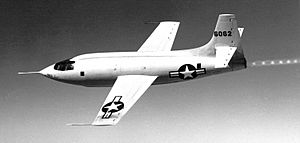
In World War II, the Germans used the Messerschmitt Me 163 Komet rocket-powered aircraft. The first fixed-wing aircraft to break the sound barrier in level flight was a rocket plane – the Bell X-1. The later North American X-15 broke many speed and altitude records. It also laid much of the groundwork for future aircraft and spacecraft designs. Rocket aircraft are not commonly used today, though rocket-assisted take offs are used for some military planes. Recent rocket aircraft include the SpaceShipOne and the XCOR EZ-Rocket.
Ramjet and Scramjet Aircraft: Extreme Speed Engines
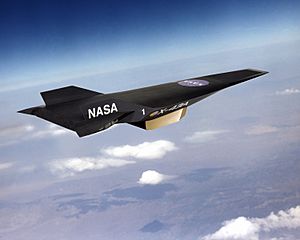
A ramjet is a type of jet engine with no major moving parts. It's useful for small, simple engines needed for high-speed uses, like missiles. The D-21 Tagboard was a Mach 3+ spy drone that was canceled in 1971. The Lockheed SR-71 Blackbird's engines ran 80% like ramjets at high speeds.
Scramjet aircraft are still being tested. A scramjet has a very simple engine design. It works by forcing air into one side of a tube-like engine. Fuel ignites that air, making it come out hotter and faster on the other side. This engine needs high speed to work, but it's perfect for the speeds it travels at. The NASA X-43 is an experimental unmanned scramjet. It holds the world speed record for a jet-powered aircraft – Mach 9.7, almost 12,000 km/h (7,500 mph) at an altitude of about 36,000 m (118,000 ft). The X-43A set this flight speed record in 2004.
Image gallery
-
Military airplanes in Russia
-
An airplane used for research by NASA
-
Early airplanes in a battle in France
-
A kite in flight
Images for kids
-
A Boeing 737 airliner is an example of a fixed-wing aircraft.
-
The fixed wings of a delta-shaped kite are not rigid.
-
Wright Flyer III piloted by Orville Wright over Huffman Prairie, October 4, 1905.
-
Santos-Dumont's self-propelled 14-bis on an old postcard.
-
A 1943 USAAF Waco CG-4A.
-
Chinese dragon kite more than one hundred feet long which flew in the Berkeley, California, kite festival in 2000.
-
A quad-line traction kite, commonly used as a power source for kite surfing.


